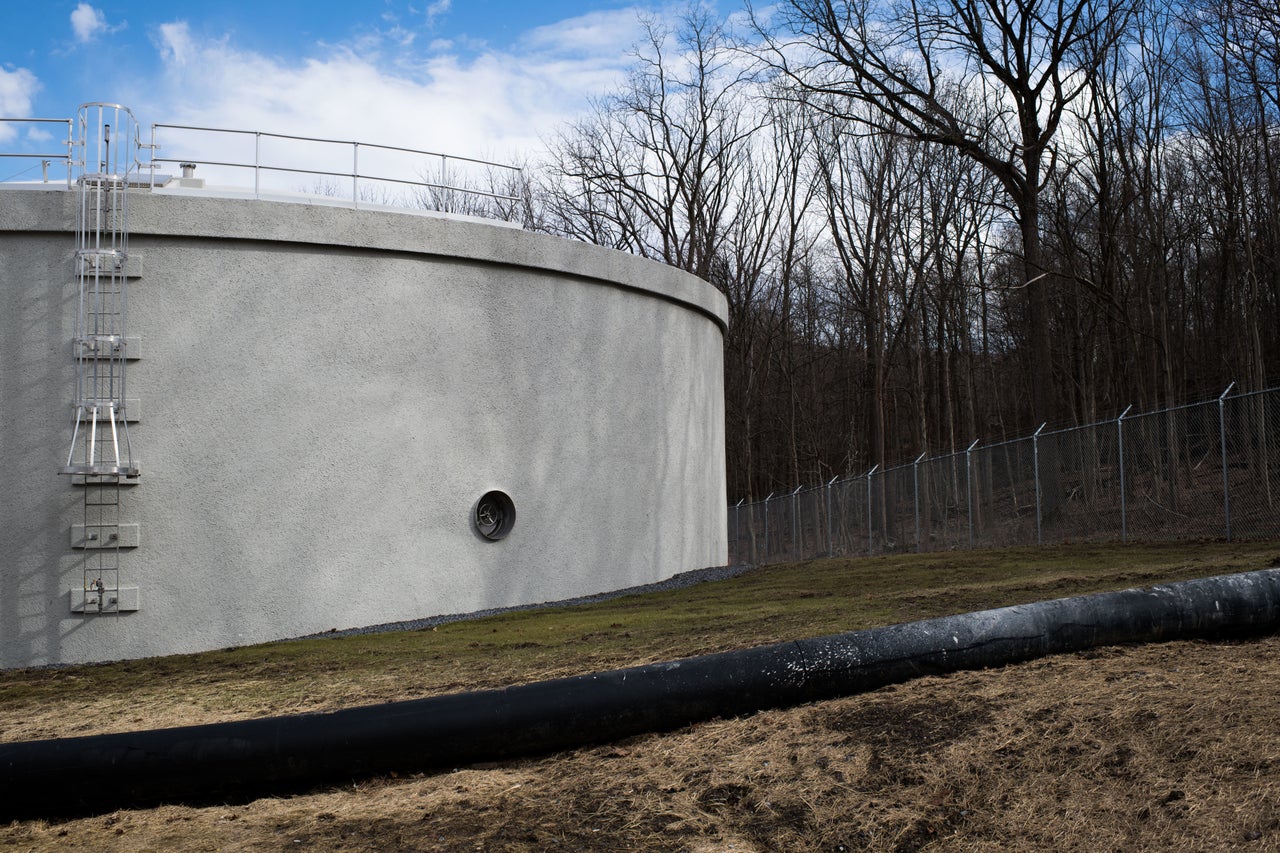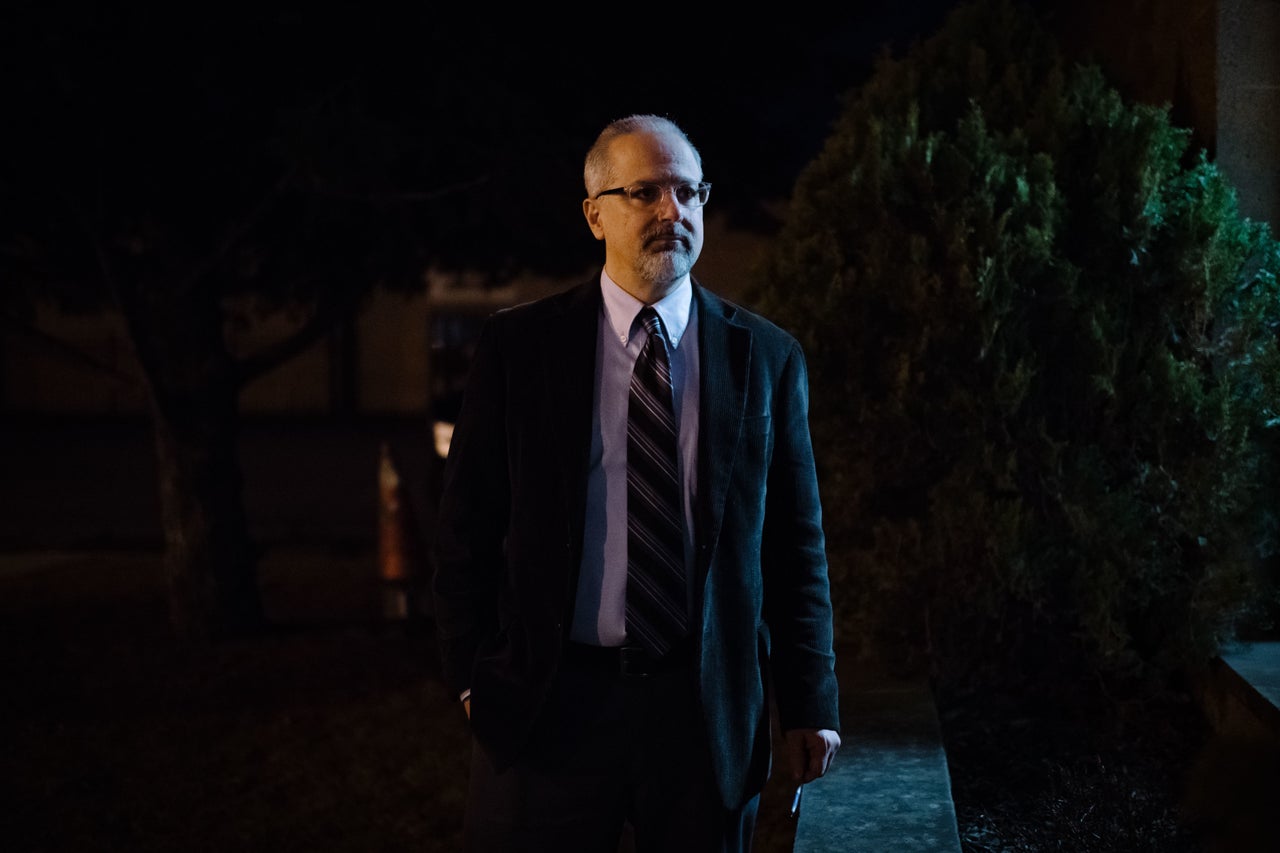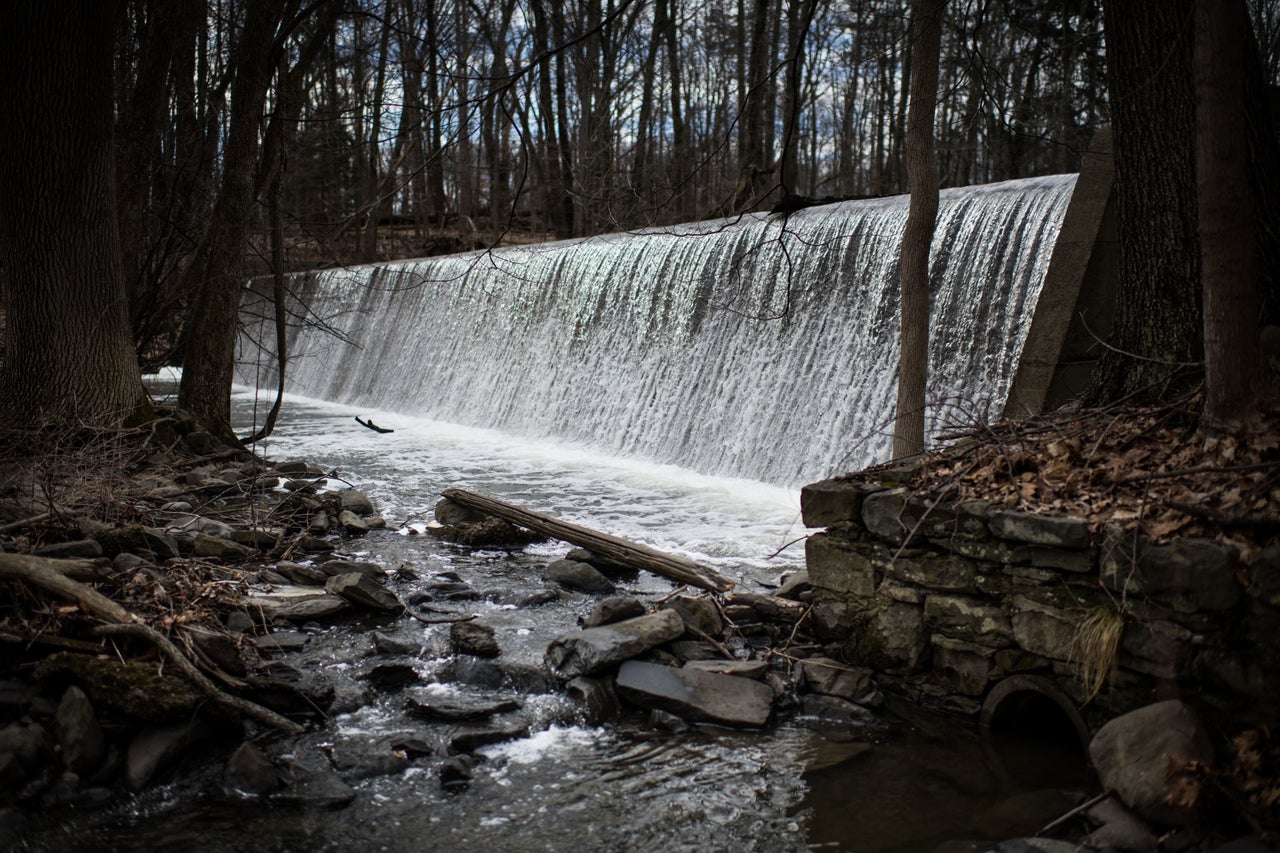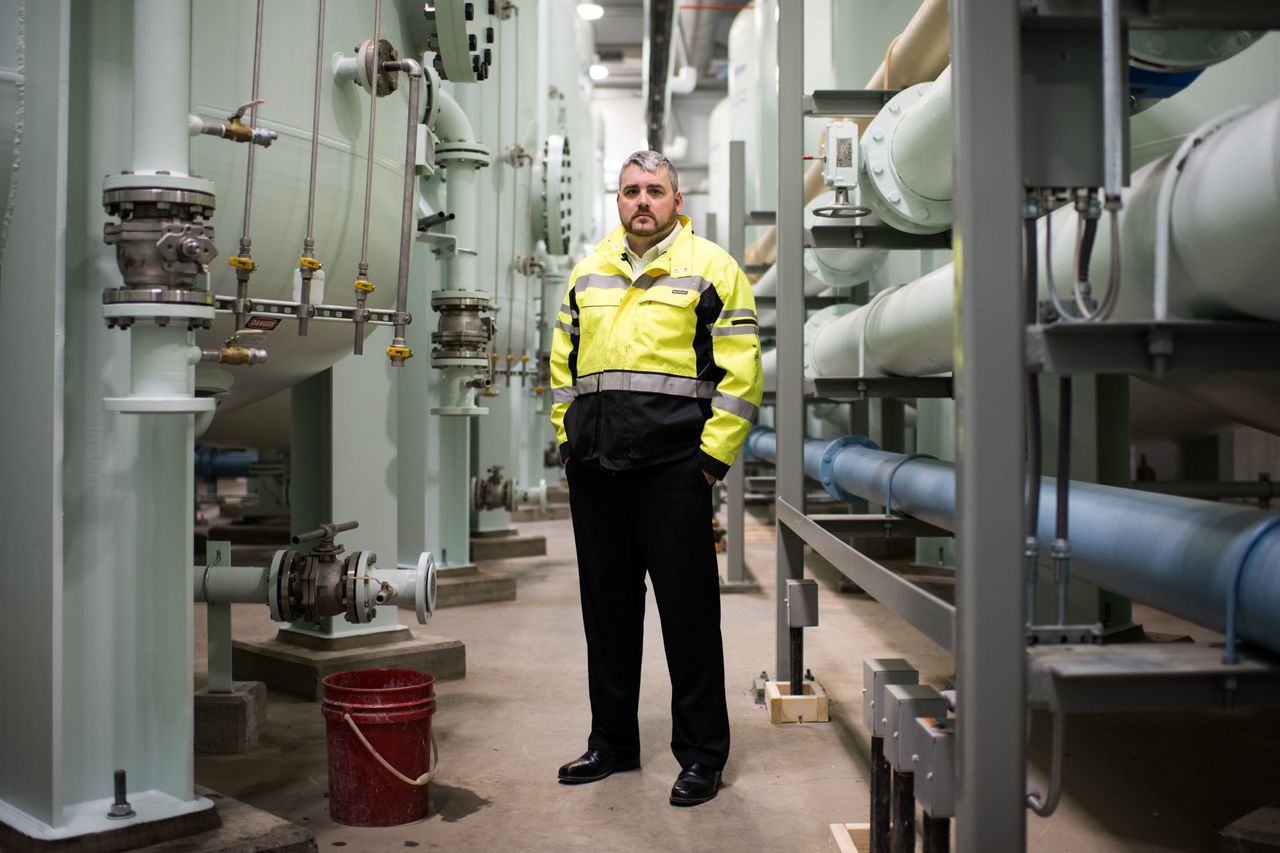NEWBURGH, N.Y. ― Lately, Wayne Vradenburgh daydreams about a demotion.
Vradenburgh has spent his entire career working for the water department of Newburgh, an upstate New York city of 28,000 people, most of whom are Hispanic or black. He started as an assistant water maintenance mechanic at 18, repairing fire hydrants. Two decades later, in 2016, he took the top job of superintendent. He made plans to fix leaky pipes, and mostly just aspired to keep things running smoothly for the poverty-stricken city of dilapidated brownstones nestled on the Hudson River.
Then, a mere two weeks after he took over, state health officials pulled up in his driveway. They had grim news. Lake Washington, the 1.3 billion-gallon reservoir that had served the city since the 1880s, had tested positive for a dangerous chemical. Vradenburgh soon found himself frantically studying the names of tongue-twister chemicals he’d never heard of, going head-to-head with state and federal agencies, and working 70-hour weeks overseeing $50 million in emergency projects.
“It’s been a whirlwind ever since,” said Vradenburgh, 40, as he brushed his hand through his hoary hair, which contrasted starkly with his sandy brown, neatly trimmed beard. “I’ve got a lot more grays now.”
The contamination started back in 1990 when the nearby Stewart Air National Guard Base, home to the 105th Airlift Wing of the New York Air National Guard, spilled 4,000 gallons of fire-fighting foam into a stream that flows directly into Lake Washington. That foam contained perfluorooctane sulfonate, or PFOS, an invisible, flavorless industrial chemical that clings to water molecules. PFOS has been linked to cancer, thyroid problems and chronic kidney disease, and can accelerate puberty, delay mammary gland development, lower sperm count and raise cholesterol.
The Pentagon has continued to use the foam, discharging it into pools near the airbase. Even now, the Department of Defense has only put some restrictions on its use as it researches an alternative. Even if they had stopped, the Environmental Protection Agency classifies the chemical as “extremely persistent,” meaning it takes many years to naturally degrade.
Despite this, PFOS is not federally regulated. In January 2009, the EPA issued an advisory in response to a contamination in Alabama, stating that the chemical only posed a health risk in concentrations of at least 200 parts per trillion. For its sister compound, perfluorooctanoic acid, or PFOA, the EPA warned against concentrations any higher than 400 parts per trillion.
New York already had a PFOA contamination crisis underway when Newburgh’s situation came to light. In late 2015, Hoosick Falls, a sleepy former mill town about two-and-a-half hours north of Newburgh, discovered dangerously high levels of PFOA in its water. As parallels emerged between Hoosick Falls and the lead contamination in Flint, Michigan, New York Gov. Andrew Cuomo (D) ― keen to avoid the national criticism Michigan’s leaders received ― decided in January 2016 to make New York the first state to regulate PFOA as a hazardous substance. The state added PFOS to the list of hazardous chemicals in April 2016, a first step to setting limits on maximum allowable levels.

Those moves awoke Newburgh to its own chemical crisis. Samples taken from Lake Washington in 2014 contained PFOS levels of up to 243 parts per trillion. In Silver Stream, they were as high as 286 parts per trillion. In drainage pools at the air base, that figure climbed to 5,900 parts per trillion. Near the airstrip, contamination levels skyrocketed as high as 1.9 million parts per trillion. Recognizing the urgency of the problem, the EPA in May 2016 issued a new health advisory lowering the health risk threshold to 70 parts per trillion.
That prompted Newburgh to declare a state of emergency, which temporarily banned filling swimming pools and watering lawns. The city stopped drawing water from Lake Washington and switched over to the Catskills Reservoir, the highly regulated source of New York City’s water. In August 2016, the Cuomo administration designated the air base a state Superfund site, giving the state authority to petition the Department of Defense to clean up the contamination.
The state has nearly completed construction on a new water treatment plant that will filter out PFOS. But officials in Newburgh say they don’t just want the PFOS cleaned from their water ― they want the toxic chemicals removed at the source. State health officials say the Department of Defense hasn’t moved to do so, despite getting $25 million in the defense spending bill last year for PFOS and PFOA remediation.
But Newburgh’s elected officials say the state should be doing more, too. And late last month, it announced plans to sue the state, the Department of Defense, several other federal agencies and two private companies for contaminating the water in the first place.
The lawsuits aim to force the Cuomo administration to take radical steps to change the way the state manages its watersheds, taking authority away from cities, towns and villages and putting it in the hands of the state Department of Health. That would require the governor to push for new regulatory powers from a Republican-controlled legislature to take on the military and big corporate polluters, officials say.
Cuomo has chastised the city for filing the suit, arguing that his administration is already doing everything it can. But city officials say it’s their best hope for forcing someone to take responsibility for tainting their water.
“The states must declare their inherent police powers on this matter, and the feds must quit their game of selective federalism,” said Newburgh City Manager Michael Ciaravino. “Everything is landing on local governments’ heads.”
‘A Band-Aid Approach’
For decades, the Newburgh Water Department was housed in three plain two-story, red-brick buildings less than half a mile northeast from Lake Washington, on the quiet, tree-lined Little Britain Road. But construction at the department has been almost nonstop recently.
First, backhoes exhumed a 1.3 million-gallon tank from beneath a grassy field and replaced it with a 1.5 million-gallon above-ground concrete dome, and beside that, a two-story red barn. Inside the barn, 18 sea-green cylinders, 27 feet tall and 12 feet in circumference, now whir like a giant engine. This is the new granular activated carbon filter that will remove the PFOS from Newburgh’s water.

Calgon Carbon Corporation, the Pittsburgh-based filter manufacturer, said it’s the biggest of the 45 PFOS filtration systems it’s installed across the country in the past two years. The company has sold activated carbon filters for decades to strain out bacterial and chemical contaminants, and only began selling systems to treat PFOS contamination two years ago. The company says those systems now make up 2 percent of its global sales, or roughly $15 million.
For now, the tanks hold untainted water from the Catskills Reservoir, pumping 3.1 million gallons into the town’s pipes and taps each day. But that’s just to work out the kinks. At some point in the coming weeks, the city plans to run its inaugural tests on water from Lake Washington, allowing it to flow through the screens of the shed-sized brick intake building that juts out on a dirt peninsula into the middle of the reservoir and, with the pull of gravity, gush through pipes into the new filtration system tanks. The filtered water will be tested for PFOS, the results of which will take two weeks.
But the city says just cleaning the chemical out of the water isn’t enough.
“The state has gone ahead with this Band-Aid approach, putting granular activated carbon filters at the end of the pipe to try to treat whatever chemicals would come into the system,” Alan Knauf, the attorney leading Newburgh’s lawsuits, told HuffPost. “The problem is they’re just treating contaminated water, there’s the possibility of a breakthrough of some of the chemicals, and eventually there will be a breakthrough.”
It’s Vradenburgh’s job to keep that from happening. Standing next to one of the tanks last week, he demonstrated how he will collect samples by turning one of four nozzles and pouring a splash of clear water into a cup. He swirled it around, then dumped it into a bucket. The weekly tests are expected to cost the water department $1,200 a month, nearly doubling what it used to pay for standard bacterial testing. The state has agreed to cover the costs.

“This is the rest of my career,” Vradenburgh said. He sighed and stared up the tank. For him, the effort is worth it; he lives just two miles from the plant, and has a 3-year-old daughter and one-month-old son. “But I’ll make sure that we’re good.”
Strokes, Seizures And Severe Migraines
For some residents, the plant is too little too late. At a city council meeting last week, the packed recreation center erupted in applause when Beatrice Harris, 29, stepped up to the microphone and thanked the city for its decision to sue the state.
“Personally, I think that is one of the best decisions this city has ever made,” she said.

Harris moved to Newburgh in 2006. Three years later, she met Julius Harris and fell in love. In a 22-slide PowerPoint she put together for a presentation on water contamination at the local library, she shows two pictures of them together in 2009, with the captions: “used to smile all the time,” and “feeling safe.” They married in 2013.
The next slide shows her in a hospital bed, unconscious and hooked up to IV drips.
“Had my first stroke in 2013,” she said. “And it got worse over the years. Now I have permanent neurological issues as a result. Not to mention I’m pre-menopausal, and I’m only 29.”
“Strokes, seizures, right-sided weakness, severe migraines,” she added. “I have had a pretty rough adult life.”
She’s convinced that the PFOS-laced water from Lake Washington is to blame. Harris and her husband started the Environmental Alliance of Newburgh last year to make people aware of PFOS and advocate for a complete cleanup. She is skeptical of the new filtration system. “There really is no right way to filter this out of water, no matter what they say,” she said outside the council meeting. “That’s bullshit to me.”
State health officials insist it’s too early to tell if Newburgh is experiencing increased rates of cancer or other PFOS-related diseases. The state Department of Health started a review of New York’s reported cancer cases last year, including the geographic location of each diagnosis. Once that review is complete, the agency plans to produce a report by the end of the year examining the rate and types of cancer diagnoses in Newburgh.
Yet data on PFOA- and PFOS-related diseases remain scarce. The Department of Defense’s budget this year includes funding for the Centers for Disease Control and Prevention to perform a first-of-its-kind longitudinal study of the non-cancer health effects of the chemicals. That could provide crucial big-picture context to the body of research linking the chemicals to thyroid disease and developmental problems.
“There’s emerging evidence to suggest there’s certain concerns for health effects,” said Brad Hutton, deputy commissioner at the New York State Department of Health’s Office of Public Health. “[But] there’s quite a bit of gaps in information, including what are the levels of exposure that bring those health effects.”
A Familiar Story
The health impacts of exposure to perfluorinated chemicals are clearer in places such as Hoosick Falls. The village, about an hour northeast of Albany, was built around two chemical plants that produced Teflon products. In 2011, scientists studying a massive PFOA contamination near a DuPont plant in Parkersburg, West Virginia, began releasing findings linking the chemical to a host of diseases, including kidney and thyroid cancer. In 2014, residents in Hoosick Falls became concerned about unusually high rates of kidney cancer and thyroid disease and began urging the village and state officials to test the water. In late 2015, after a resident’s privately run tests yielded alarming results, the state finally stepped in and found dangerously high levels of PFOA in the groundwater.
That finding is what prompted New York to list PFOA as a hazardous substance in January 2016. Yet, the state issued notices advising the public that their water was safe to drink even as federal regulators said otherwise, actively disputing the EPA’s concerns. At that point, the Cuomo administration had already waited more than a year do anything about the contamination, despite knowing that the PFOA levels in Hoosick Falls exceeded federal guidelines, according to a Politico investigation published in March 2016.
In July 2016, Cuomo signed legislation to make it easier for municipalities like Hoosick Falls to sue polluters ― in the village’s case, two giant chemical manufacturers ― over water contamination. But cleanup efforts stalled. Hoosick Falls residents soon grew so frustrated by the state’s failure to do anything to eliminate the contamination that they staged a protest outside the governor’s office in November 2016. The state finished installing a filtration system in Hoosick Falls in February 2017, and also established a Drinking Water Quality Council in September to address drinking water problems across the state.
But Judith Enck, New York’s former regional EPA administrator for eight years under President Barack Obama, described the council as mired in “bureaucratic malaise.” It’s met just three times, and is still working on making a final recommendation on safe levels of PFOA and PFOS. Hutton, the Health Department official, said that the council is “at the real close endgame of getting a recommended level.”
In Hoosick Falls’ case, the village sued Saint-Gobain Performance Plastics and Honeywell International, the chemical companies that at different points operated the plant that polluted the groundwater. The governor supported that suit, and officials announced a $330,251 settlement with the companies last week.
But now Newburgh is targeting Cuomo, and the governor has come out swinging. At a press conference at Marist College in Poughkeepsie late last month, Cuomo criticized the city for its impending lawsuit.
“Why they would threaten litigation ― you know ― they have to feed lawyers,” Cuomo said.

Ciaravino, Newburgh’s city manager, scoffed at the governor’s remark.
“We’re a city that’s facing 12 firefighter layoffs,” he told HuffPost. “We have a lot of financial challenges. The last thing we want to do is enrich lawyers.”
What he does want is for the state to take control over the watershed. It wouldn’t be an unprecedented move. In 1997, New York adopted rules that gave regulators in New York City and the towns located on its watershed new powers under the state Department of Health to protect the Catskills Reservoir and any tributaries that feed it. The rules, called the Watershed Rules and Regulations, established a unified code mandating the same standards for zoning, permitting and wastewater treatment across the entire watershed.
The rest of the state relies on drinking water regulations passed in the early 1900s. As a result, water rules generally address pollution sources such as cesspools, garbage, animal manure and industrial discharges, but make no mention of modern contaminants such as sediment, fertilizer, pesticides and road salt, according to a memo from Hudson Valley Regional Council, a county agency in Newburgh.
“We’re a city that’s facing 12 firefighter layoffs. We have a lot of financial challenges. The last thing we want to do is enrich lawyers.”
- Newburgh City Manager Michael Ciaravino
“What we see in the case of New York City is the world-class example of protecting drinking water at its source,” said Dan Shapley, the water quality program director at the New York-based watchdog group Riverkeeper. “But those same rules and regulations have not been updated for other communities in New York State for 100 years or close to it.”
Newburgh is a paradigm of the problems that the current web of water jurisdictions creates. The state owns the air base that polluted the stream that feeds Lake Washington, but leases the property to the federal government. One quarter of the reservoir is located in the town of Newburgh, a separate, confusingly larger neighboring municipality of roughly 30,000 people, located to the city’s north and west. The other 75 percent is technically part of the town of New Windsor. The City of Newburgh pays property taxes to both of them.
Then there’s the development issue. In recent years, the town of Newburgh has been building up a strip of big-box retailers on Route 300, a thoroughfare that runs along the western bank of Lake Washington. Shapley warned that runoff from stores poses yet another risk to the water.
Changing watershed regulations across the state would require transferring many zoning and permitting powers from towns and villages to larger municipal bodies, such as counties or even the state itself. The constitutional grounds to do so are solid, according to John Nolon, a law professor at Pace University and counsel at the school’s Land Use Law Center.
There aren’t legal obstacles to solving the problem, Nolon said, but introducing a bill to strip towns of key powers could be career suicide for a state lawmaker.
“That is a politically very fraught task, because state legislators within the Assembly or Senate, they’re all local politicians and they all run for office,” he said. “When they go home, it’s difficult for them to say, ‘We just took away the town’s power to determine its future.’”
No Political Clout
If the state committed an original sin in Newburgh’s contamination case, Ciaravino sees it not as the 1990 PFOS spill, but the state’s classification of Silver Stream as a Class D stream, which allowed the Department of Defense to obtain permits to discharge into it in the first place. The stream should have been designated under Class A, meaning it provides drinking water and therefore should not be used for waste.
“It was a simple error in labeling on the map,” said Martin Brand, deputy commissioner for remediation at the New York State Department of Environmental Conservation. He declined to comment on “whether it was appropriate to discharge [into the stream] or not,” noting that PFOS was not regulated until 2016. Yet, he insisted the body of water was “all appropriately mapped.”
The Department of Defense did not respond to repeated calls and emails requesting comment.
For the last two years, Silver Stream has been severed from Lake Washington by a thick steel diversion gate, locked with three chained-together, rust-covered wheel cranks. Cut off from the lake, the stream gushes over a cement dam and through the woods and into the Hudson River. The lake remains stagnant, full of water with a contaminant that won’t disintegrate anytime soon.

Ciaravino worries Newburgh may have one thing stacked against it that a village like Hoosick Falls doesn’t. Hoosick Falls is nearly 98 percent white, according to census data. Newburgh is 52 percent Hispanic and 26 percent black. Historically, studies show those demographics suffer worse from pollution than white Americans, and receive far fewer resources to mitigate it.
Even without the PFOS contamination, Newburgh’s water is dirty. The Environmental Working Group’s tap water database shows levels of trihalomethanes ― cancer-causing contaminants that form during the water treatment process ― roughly three times higher than the state and national average, though still within legal limits. Chromium, a carcinogenic pollutant linked to industrial waste, appears at levels three times EWG’s guidelines, which are based on combined state and EPA advisories. And that’s just based on the data available in 2015.
“Maybe we just don’t have the political juice over the last 20 years to advocate for our own safety needs,” Ciaravino said.
Even if Newburgh fails to force the state to take more drastic action to clean up the contamination and change the way watershed jurisdictions work, its lawsuit could open the doors to a flood of litigation against the Defense Department, one of the nation’s top polluters.
The military is responsible for 140 federal Superfund sites, according to the EPA ― more than any other civil entity. And the problem could be much bigger. The Pentagon identified 391 “active and closed installations with known or suspected releases of PFOS and PFOA” as of December 2016, according to a Government Accountability Office report released last October. The report warned that there are still holes in the Defense Department’s internal data.
“Almost every military base, almost every firefighter-training session, used massive amounts of PFOS,” Enck told HuffPost. “We are really in the middle of an emerging national crisis.”
This story was updated to include additional sampling data on the contamination.
